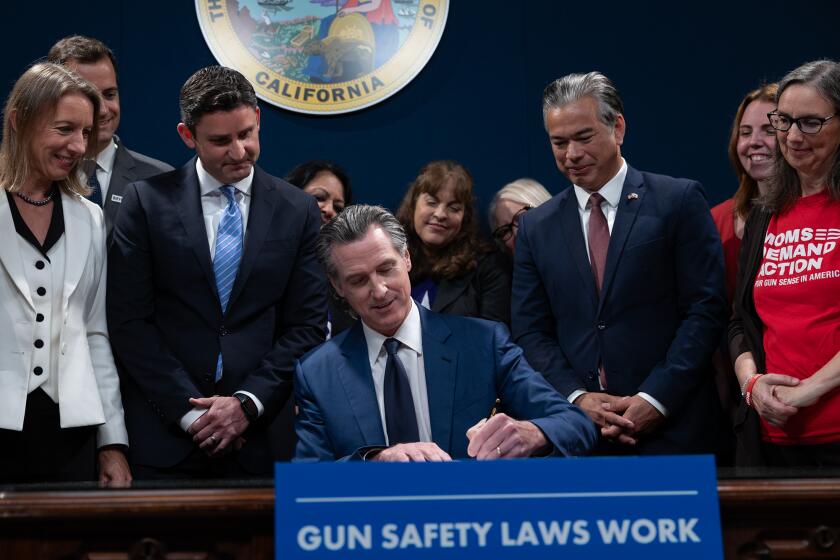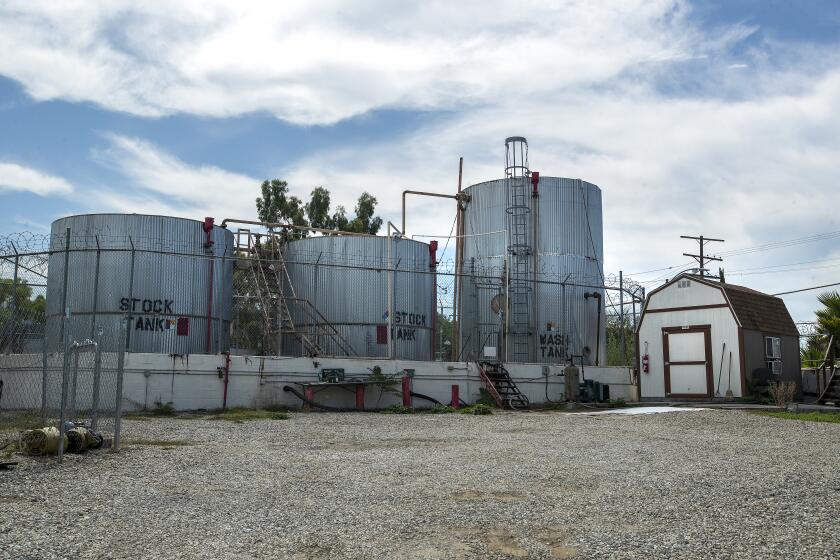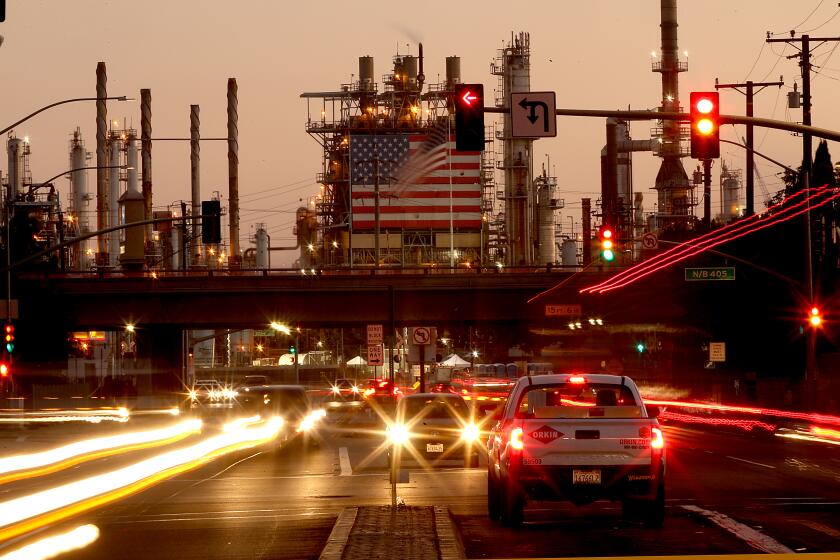
- Share via
As rising fossil fuel emissions continue to push global temperatures to record highs, California Gov. Gavin Newsom will head to China next week to meet with officials on such environmental imperatives as offshore wind power, air pollution reduction and the transition to fully electric vehicles, according to the governor’s staff.
The visit, which is likely to boost Newsom’s reputation as a national leader in climate policy, comes at a time of increasing economic and military tension between Washington and Beijing.
Although friction between the world’s largest greenhouse gas emitters makes binational cooperation difficult, experts say California can help to bridge this gap through ‘subnational’ diplomacy — encouraging international cooperation and forging climate-focused partnerships.
“We’re fighting on two fronts: Can America and China learn to live in the world together, and can we, together, take steps to reduce greenhouse gas emissions?” said former Gov. Jerry Brown, chair of the California-China Climate Institute at UC Berkeley.
Aggressive and impactful reporting on climate change, the environment, health and science.
California has been engaged in climate talks with Chinese provinces since at least the Schwarzenegger administration, when the state began actively pursuing subnational relationships with other jurisdictions interested in various aspects of the climate crisis.
But major alliances began in earnest when Brown signed a 2013 memorandum of understanding with China committing to joint efforts to promote clean energy, reduce carbon emissions and other climate goals.
In particular, the cities of Shenzhen and Guangzhou, located in the Guangdong Province near Hong Kong, showed interest in the state’s then-burgeoning cap-and-trade program, and in testing similar market-based carbon emissions programs. Newsom is expected to visit the region and sign an agreement with local officials about decarbonizing industry and promoting clean energy.
Currently, China is responsible for about 30% of global carbon dioxide emissions, compared with about 14% from the U.S. and less than 1% from California.

“California needs to not only lead in its own jurisdiction — it needs to get other followers to come on board,” said Michael Davidson, an assistant professor in engineering and policy at UC San Diego. “And with China as the largest greenhouse gas emitter by far globally, I can’t think of a better target ... to try to follow along in some of the positive steps that California has been taking.”
Here’s a roundup of highlights — or lowlights, depending on your views.
California has an ambitious goal of achieving carbon neutrality by 2045, while the U.S. seeks to do the same by 2050. China is targeting 2060.
Neither nation, however, is on track to achieve the emissions reductions needed to contain warming to 1.5 degrees Celsius as specified in the Paris climate agrement, according to the Climate Action Tracker, a project following government action on global warming.

That’s partly why emissions and air quality will be a chief topic during Newsom’s visit. Both California and China have historically struggled with pollution, albeit for different reasons: In California, the transportation sector is the largest source of pollution and greenhouse gas emissions, with traffic and ships also contributing to Los Angeles’ infamous smog.
In China, the primary culprits are industrial emissions, electricity production and manufacturing. Pollution from coal-fired power plants, steel mills and factories have resulted in some of the world’s worst levels of particulate matter, and the country continues to see high rates of lung and heart disease.
In January 2013, Beijing experienced a four-day episode known as “airpocalypse,” during which particulate levels reached a daily peak average of nearly 570 micrograms per cubic meter — eight times the national health standard.
The governor passed bills requiring corporations doing business in California to disclose their greenhouse gas emissions, and oil and gas companies to pay more to cover costs of plugging old wells.
The incident prompted Chinese leaders to launch a national “war against pollution” that saw particulate levels drop 42.3%, according to the Energy Policy Institute at the University of Chicago.
Chinese officials have been studying California’s approach to reducing smog as part of their work to clean up the air, including visits to meet with the state’s Air Resources Board, Newsom aides said.
China accomplished the dramatic reduction by prohibiting new coal mines, restricting road traffic, expanding its air quality monitoring network and curtailing steel and iron production in the most polluted regions. The country also followed in California’s footsteps and established a national cap-and-trade program focused on power-generating facilities in 2021.
Southern California air regulators adopted a rule that has forgiven more than $200 million in pollution fees from facilities that emit smog-forming chemicals.
But even as China makes gains, its greenhouse gas emissions have continued to rise about 10% since 2014 due to growth in its energy and industrial sectors. And particulate pollution, although improved, is still six times that of World Health Organization’s guidelines.
“The latest efforts to decouple the economy from carbon and energy intensity has not yet ‘turned the supertanker,’” said Swithin Lui, a policy expert with Climate Action Tracker.
In other areas however, China has lessons it can offer California.
China has been even more aggressive than the U.S. and California in promoting and pursuing electric transportation, including a nationwide push for new businesses and infrastructure in support of electric vehicles. China had been aiming for 20% of all car sales to be electric or hybrid vehicles by 2025, but surpassed that goal in 2022.
Newsom is expected to visit a Tesla factory in Shanghai that has manufactured 2 million cars since opening in 2019. He’s also planning on visiting a bus depot in Shenzhen that was the first in the world to transition to an all-electric bus fleet, aides to the governor said.
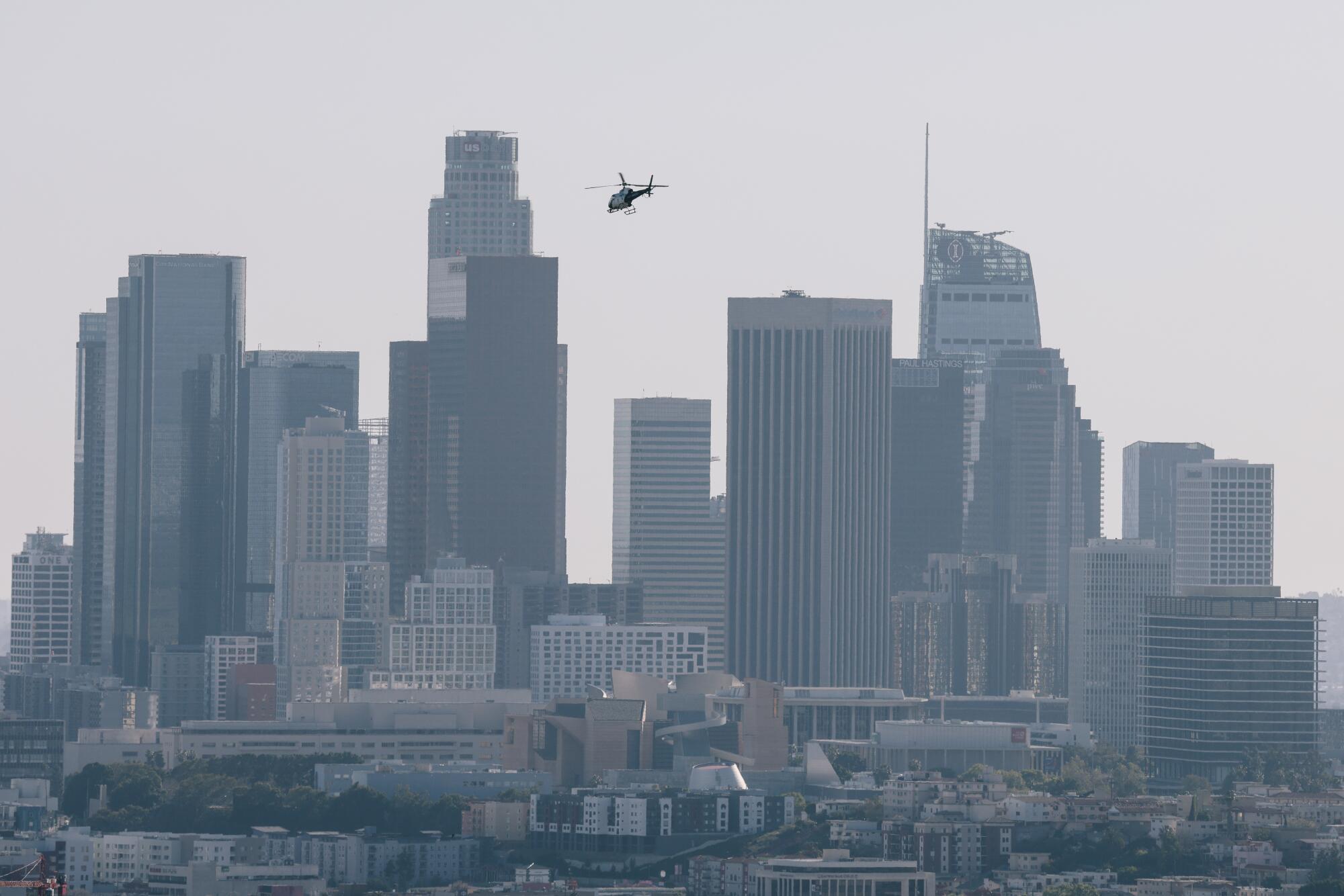
Meanwhile, the Golden State faces many hurdles in its race to ban the sale of gas powered cars by 2035, including the need for more public and private vehicle charging stations, as well as the need for more affordable electric vehicles. More than half of the world’s electric vehicles are currently sold in China.
“It’s not strictly a one-way street,” said Mary Nichols, vice chair at the California-China Climate Institute and former chair of the California Air Resources Board. “There really is collaboration that goes on.”
Global surface temperatures last month were 2.25 degrees above the 20th century average of 60.1 degrees, surpassing the record set in August 2016.
Indeed, Newsom’s trip comes only months after he signed his own memorandum of understanding with the Chinese province of Hainan outlining collaborative goals including cutting air pollution, advancing clean energy, accelerating zero-emission vehicles and developing carbon neutrality plans.
The previous year, the governor signed an even broader MOU expanding the state’s partnership with the Chinese Ministry of Ecology and Environment, equivalent to the U.S. Environmental Protection Agency.
Experts said it’s unusual for a state to have that kind of agreement with a large central government, but that it speaks to the value of such an exchange for both sides trying to meet their own domestic climate goals.
It also allows California to skirt some of the larger geopolitical tension between Washington and Beijing.
In August, China conducted sweeping military drills in an apparent show of force after American officials visited Taiwan. That same month, Biden issued an order restricting some U.S. tech investments in China.
In March, U.S. officials conducted fiery congressional hearings over whether to ban the Chinese-owned social media app TikTok over national security concerns. And in January and February, a Chinese surveillance balloon captured the nation’s attention as it floated from Montana to South Carolina before being shot down by a U.S. Air Force fighter jet.
Such events have left little room for climate talks, said Kenneth Lieberthal, a senior fellow emeritus in the foreign policy program at the Brookings Institution, a think tank based in Washington.
He noted that requests for speedier climate actions from U.S. climate envoy John F. Kerry were rebuffed following Kerry’s visit to China this summer. He said state and local leaders such as Newsom may be needed to foster greater cooperation.
“I think the politics make it very hard to do, and at the highest level, the politics make it impossible,” Lieberthal said. “But just below that, I think there’s a lot that can be done sensibly, especially with governors of states like California that have already done a lot with the Chinese over the years.”
Plug-in hybrid cars are an often overlooked alternative to full electric vehicles. But will they help the warming world? It’s controversial.
Newsom’s trip also comes at a crucial moment for global climate action, as extreme weather events including floods, wildfires and heat waves continue to threaten vulnerable populations, test infrastructure and ramp up demand on outdated energy grids.
That’s another arena in which California could lead, since the state already demonstrates one of the cleaner energy grids in the U.S. About 60% of California’s electricity comes from low-carbon sources, while about 60% of China’s power comes from coal.

Even as China ramps up its renewable energy efforts — including an expected 1,200 gigawatts of wind and solar energy by 2025 — the country is continuing to build new coal plants to act as fail-safes during times of high energy use. In the first half of this year alone, China added 52 new gigawatts of coal power.
Lieberthal said those actions speak to China’s broader strategy of allocating more resources toward adapting to a warmer world rather than reducing emissions. China has built seawalls to hold back rising seas and removed pavement to allow floodwaters to drain more easily in so-called “sponge cities.” Meanwhile, it has not seemed willing to accelerate its 2060 net-zero goal at the behest of Kerry or others.
“They have made the assumption that the reality is the world will be at above 2 degrees centigrade within a matter of decades,” Lieberthal said. “Their target is to make the conditions of that world sustainable for the Chinese population so that it keeps the population shy of massive catastrophe and social disintegration, which it otherwise would probably face. And so they have focused very heavily on climate adaptation.”
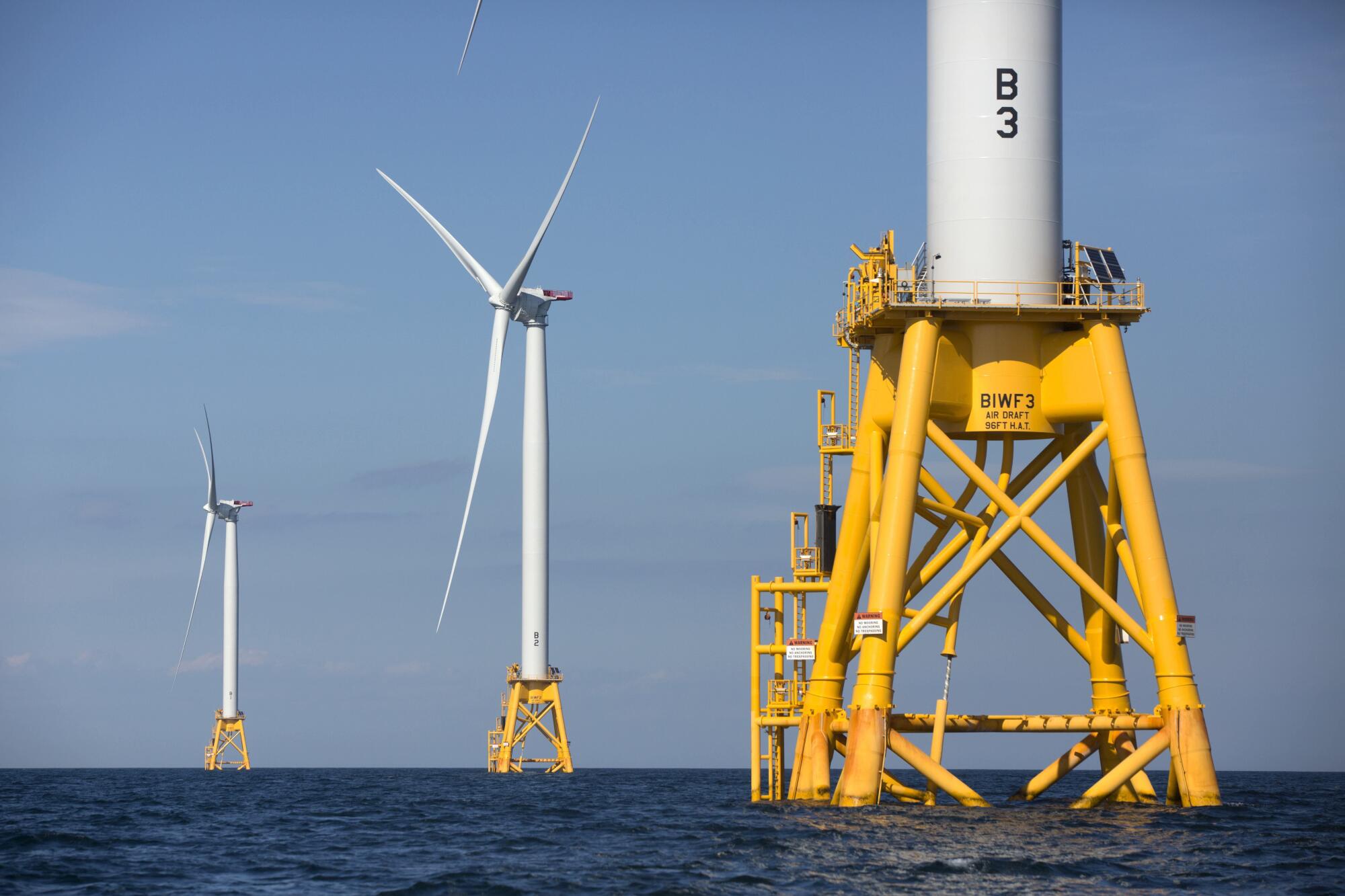
Newsom’s renewable energy discussions in China probably will also include offshore wind turbines, experts said.
China has a booming offshore wind sector while the U.S. has shown much slower progress in that space. Although California has announced its desire to build several gigawatts of offshore wind energy by 2045, ocean depths off the West Coast present an engineering challenge, since turbines must be mounted on floating platforms. The only existing offshore wind farms in the U.S. are currently off the East Coast in the Atlantic, where turbines can be attached directly to a shallower seafloor.
“It is difficult to map one-to-one how Chinese pollution policies have reduced greenhouse gas emissions, but it is certainly the case that those policies helped promote the use of renewable energy sources” over more polluting fuel sources, said Christa Hasenkopf, director of the University of Chicago Energy Policy Institute’s annual global air quality assessment.
Plenty of challenges lie ahead as California mandates zero-emission cars, including cost and access to charging.
California’s own emissions reduction work has already had a strong effect on the U.S. market and policies, and reaching out to China and other countries is yet another way for the state to demonstrate its global leadership on climate, experts said.
“I think Newsom is showing some wisdom and some courage in going, because climate is not waiting for Israel, the United States or Vladimir Putin,” Brown said. “It is inexorable. Every moment, every day, things are getting worse, and so we have to deal with it — you can’t avoid it.”
Davidson, of UC San Diego, said Biden’s upcoming November meeting with Chinese leader Xi Jinping in San Francisco is a positive step toward continued dialogue on climate change, global health and other issues. However, substantive progress could be hampered by the nations’ complex relationship.
He lauded California for cultivating robust long-term engagement with China that has lasted for decades.
“It has gone through multiple administrations — through high levels and low levels of ambition in Washington — and it’s really just persisted,” he said. “And that’s a real asset in trying to resolve the climate issue.”

